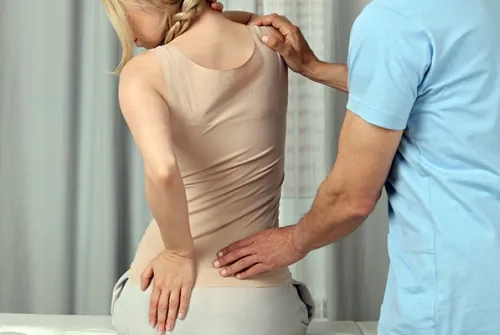Alo Yeditepe
Alo Yeditepe
Maigne Syndrome and Treatment
Rapid Rotational Movements for Relieving the Back and Spine Can Cause This Problem!
Back pain is one of the most common types of pain in the society. Therefore, it is naturally assumed that most of the pain experienced in the back, spine, and even hip area is related to the back. A specialist in Physical Medicine and Rehabilitation, stated that the little-known but highly prevalent Maigne Syndrome is the cause of approximately 40% of patients presenting with back pain. She emphasized that the misdiagnosis of patients due to the frequent association of back pain with herniated disc and persistent groin and testicular pain with internal organ diseases can lead to inappropriate and time-consuming treatment methods.
The Common But Little-Known Cause of Back Pain
Specialist in Physical Medicine and Rehabilitation at Yeditepe University Hospitals, provided information that all painful conditions resulting from dysfunction at the junction of the "lower thoracic-upper lumbar vertebrae" of the spine are defined as Thoracolumbar Junction Syndrome (TLJS), also known as Maigne Syndrome. She explained the frequently overlooked but significant cause of back pain as follows: "This syndrome is most commonly observed between the 11th and 12th thoracic vertebrae and the 1st lumbar vertebra. Unilateral sensitivity in the facet joint, which is the joint that connects and prevents displacement between the affected vertebrae, causes pain. The nerves emanating from this region may manifest with abnormal symptoms in the corresponding muscle, bone, and skin areas that they innervate. Patients often complain of pain or decreased sensation in the lower back, pelvic bone, buttocks, groin, and testicular region, rather than in this lower thoracic-upper lumbar transitional region."
highlighted the importance of patients with unexplained lower abdominal pain, side pain (flank pain), groin and testicular pain, as well as individuals experiencing unexplained back pain, seeking the evaluation of a physical therapy physician with suspicion of Maigne Syndrome to prevent delays in diagnosis due to misdiagnosis.
"Pain Occurs After Sudden Torsional Movements of the Trunk"
Specialist emphasizing that this syndrome usually begins after rotational trunk movements and that the pain increases with bending to the opposite side while standing, said, "The rotational movement of our spinal column is limited due to our ribs. The flexion and rotation movements of our lower back (lumbar spine) predominantly occur at the level of the thoracolumbar junction. Therefore, strains caused by sudden bending and twisting movements are the most important factors in the development of this syndrome." She indicated that sudden rotational movements of the back and spine are commonly observed in athletes performing rotational movements along with stretching and rotation, but this problem can also occur in individuals from all walks of life. TLJS can occur in young people as well, but it is more frequently seen in the population over 50 years of age due to decreased muscle strength in the lateral aspects of the spine and degeneration associated with aging in that region.
It Can Mimic Internal Organ Diseases Besides Herniated Disc!
Specialist stated, "Patients usually cannot describe the pain located in the back, but the most common complaint is back pain." She continued, "The pain concentrates in the lower back area, beside the pelvic bone, gluteal region (buttocks and coarse meat), and the sacroiliac joint region (located between the pelvic bone and the sacrum at the junction of the lower spine). It also spreads to the groin area and the inner side of the thigh and manifests itself as persistent groin and testicular pain. It is noteworthy that this symptom is often confused with internal organ diseases and urinary tract infections, leading to misdiagnosis and inappropriate treatment." She stated that another feature of the syndrome is that the pain increases with coughing, sneezing, and straining.
“It Can Be Confused with Different Diseases”
Specialist stating that clinical findings and medical history are crucial in diagnosing the disease, said, "In addition to a detailed medical history and physical examination, diagnostic interventions such as diagnostic blocks can be performed. While diagnostic blocks are being performed to confirm the diagnosis, symptoms significantly improve or completely disappear. To confirm the diagnosis, further diagnostic methods such as X-rays, MRI, and CT can also be used."
“Different Treatment Approaches Accordıng to the Functional Disorder in the Spine”
Specialiststated that the treatment of Maigne Syndrome is primarily based on eliminating the trigger factors that cause pain and inflammation. She explained the treatment options as follows: "In the treatment process, medications that will relieve the inflammation and pain in the region are used, and the muscles in the painful area are relaxed with muscle relaxants. Physical therapy, which includes stretching and strengthening exercises to improve flexibility and muscle strength, plays a significant role in the treatment process. Local injections applied under imaging guidance can also provide pain relief and accelerate the healing process. In severe cases that do not respond to these methods, surgical intervention may be considered as a last resort."
Press Coverage: posta | gazetepencere | cnnturk | haberturk | yenicaggazetesi | yeniakit
This content was prepared by Yeditepe University Hospitals Medical Editorial Board.
Alo Yeditepe


